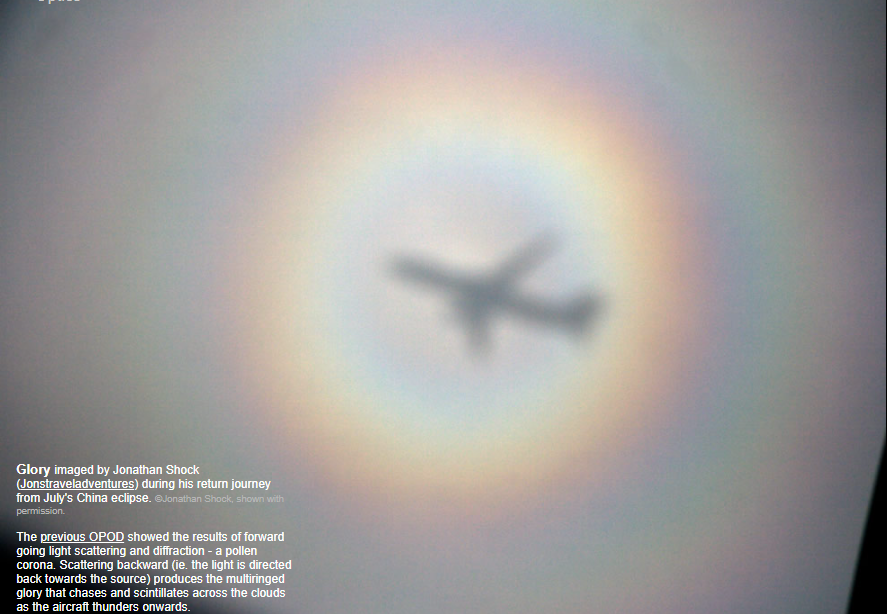Transparent Glories
Transparent Glories: A Phenomenon of Atmospheric Optics
Have you ever looked up at the sky and noticed a captivating display of multiringed colors chasing and scintillating across the clouds? This mesmerizing optical phenomenon is known as a "glory." In this article, we will delve into the fascinating world of transparent glories and explore their formation and the science behind them.
Glories are created through a combination of light scattering and diffraction. While the previous Optical Phenomena of the Day (OPOD) showcased the forward scattering that produces a pollen corona, the glory is formed by the backward scattering of light. In this case, the light is directed back towards its source, creating a stunning display of concentric rings.
Unlike a corona, which can be formed by any objects such as water droplets, pollen grains, or even lumps of coal, a glory requires transparency. The light passes through cloud droplets, undergoing at least one internal reflection and propagation by "surface waves." These interactions between light and water droplets give rise to the vibrant colors and intricate ring patterns characteristic of a glory.
The formation of a glory is a complex process involving multiple factors. Here are some key points to consider:
-
Light Scattering: Glories are primarily formed through the scattering of light. As sunlight passes through tiny water droplets in the atmosphere, it scatters in various directions. The size of the droplets plays a crucial role in determining the appearance of the glory.
-
Diffraction: In addition to scattering, diffraction also contributes to the formation of a glory. Diffraction occurs when light waves encounter an obstacle or pass through a narrow opening, causing them to spread out and interfere with each other. This interference pattern gives rise to the distinct rings observed in a glory.
-
Internal Reflection: As light enters a water droplet, it undergoes internal reflection, bouncing off the droplet's inner surface. This reflection occurs multiple times within the droplet, leading to the concentration of light at specific angles. These concentrated beams of light contribute to the formation of the glory's rings.
-
Surface Waves: The propagation of light within the water droplets also involves "surface waves." These waves travel along the boundary between the droplet and the surrounding air, interacting with the incoming and reflected light. The interplay between these surface waves and the internal reflections further enhances the glory's appearance.
-
Angle of Observation: The angle at which an observer views a glory affects its visibility and size. Glories are most commonly seen when an observer is situated in an aircraft or on a mountaintop, looking down onto a cloud layer below. From this vantage point, the concentric rings of the glory appear to encircle the shadow of the observer.
Understanding the science behind transparent glories allows us to appreciate the intricate beauty of these atmospheric phenomena. The interplay of light, water droplets, and diffraction creates a captivating display that enchants and mesmerizes all who witness it.
In conclusion, transparent glories are a result of light scattering and diffraction, as well as internal reflections and surface waves within water droplets. Their formation and appearance depend on various factors, including the size of the droplets and the angle of observation. Next time you find yourself gazing at the sky, keep an eye out for these enchanting rings of color dancing across the clouds – a true testament to the wonders of atmospheric optics.

Glory imaged by Jonathan Shock (Jonstraveladventures) during his return journey from July's China eclipse. ©Jonathan Shock, shown with permission.
The previous OPOD showed the results of forward going light scattering and diffraction - a pollen corona. Scattering backward (ie. the light is directed back towards the source) produces the multiringed glory that chases and scintillates across the clouds as the aircraft thunders onwards.
Unlike the corona that is made by any objects - water drops, pollen grains, lumps of coal - the glory must have transparency. The light passes through cloud droplets with at least one internal reflection plus propagation by 'surface waves'.
Where was Jon sitting?
More:
Glories
Their formation
Light scattering
Note: this article has been automatically converted from the old site and may not appear as intended. You can find the original article here.
Reference Atmospheric Optics
If you use any of the definitions, information, or data presented on Atmospheric Optics, please copy the link or reference below to properly credit us as the reference source. Thank you!
-
<a href="https://atoptics.co.uk/blog/transparent-glories/">Transparent Glories</a>
-
"Transparent Glories". Atmospheric Optics. Accessed on April 26, 2024. https://atoptics.co.uk/blog/transparent-glories/.
-
"Transparent Glories". Atmospheric Optics, https://atoptics.co.uk/blog/transparent-glories/. Accessed 26 April, 2024
-
Transparent Glories. Atmospheric Optics. Retrieved from https://atoptics.co.uk/blog/transparent-glories/.